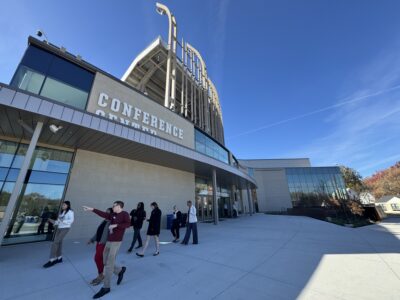COVID-19 spreading half as quickly in counties with mask mandates, KU research shows

photo by: Conner Mitchell/Journal-World
A man exits the Kansas Union wearing a mask on Monday, Aug. 10, 2020.
Kansas counties that have mandated the use of face masks in public have seen much lower spread of COVID-19 than the statewide average, new research from the University of Kansas shows.
The analysis by KU’s Institute for Policy and Social Research found that counties with mask mandates had roughly half as many cases of the respiratory virus as the statewide average when adjusted for population. Donna Ginther, a professor of economics and the director of the IPSR, and Carlos Zambrana, an associate researcher, conducted the study.
Kansas Gov. Laura Kelly issued a statewide mask order on July 2, but it allowed counties to opt out of the order at their individual discretion — a side effect of legislation passed in June that limited some of Kelly’s emergency management powers. This situation meant that Kansas was essentially conducting a live experiment on the efficacy of masks, Ginther told the Journal-World. Kelly announced this week she hopes to work with Kansas House and Senate leaders to institute a bipartisan, statewide mask mandate.
Roughly two dozen of Kansas’ 105 counties went along with Kelly’s July order or implemented their own mandates shortly thereafter. Ginther said the counties with mask mandates saw a significant slowdown in new virus cases. Specifically, counties with mask mandates saw an average of about seven new cases each day per 100,000 residents, as compared to the statewide average of about 14 new cases per day per 100,000 residents.
Notably, Ginther said that when she and Zambrana controlled the data to account for social distancing measures, the masked counties still saw about 50% as much spread as the statewide average. In other words, the counties with mask orders didn’t see their cases drop because they were better at practicing other recommended public health measures — the sole factor of wearing a mask was enough to slow the spread of the virus.
“The mask-wearing didn’t stop people from moving around. It didn’t stop people’s movements, but it stopped the spread of the disease,” Ginther said. “We all want normal, but normal’s not going to come for many more months. We have to do a second best, and (wearing a mask) seems like a really good candidate.”
Ginther said this analysis — which runs through October — leaves little to interpretation.
“Now if you just look at the data, it’s pretty clear,” she said. “One of the things about masks is that it keeps you safe when you’re in public. If we want to open up the economy and teach kids in school and get closer to a normal lifestyle before we get a vaccine, our best option is to wear a mask. Especially now that things are moving indoors.”
Ginther said she was hopeful that more people would heed public health guidance in wearing masks after seeing the data in her and Zambrana’s analysis. Despite ongoing politicization of mask-wearing at both the federal and state levels, she said there’s one reason she’s optimistic the analysis could have a real impact.
“One of the things I’ve learned from policy is that we tend to believe information that’s about ourselves. And this is about Kansas,” she said. “This isn’t about California … this is us.”
Ginther said she’s hoping to publish the analysis as a standalone article in a research journal soon, but because of the public health implications of the findings, she said it was best to release as much as she could now.
Contact Conner Mitchell
Have a story idea, news or information to share? Contact KU reporter Conner Mitchell:
- • Email: cmitchell@ljworld.com
- • Other: Tip form/Signal contact
- • Phone: 785-832-6388
- • Twitter: @ConnerMitchell0
More Lawrence Journal-World coverage of the University of Kansas




